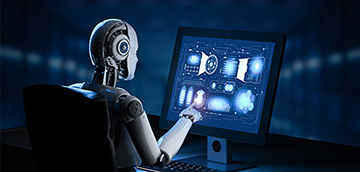Robotic desktop automation (RDA), also known as attended automation, refers to a desktop bot or virtual assistant bot that lives on an employee or end-user’s desktop. Not only does it drive efficiency and productivity, but it also helps to boost employee and increase customer satisfaction.
Robotic desktop automation: the next step forward in digital transformation
Robotic process automation (RPA) is no longer a new concept, and organizations in industries as varied as telecoms, financial services, government and retail are using the technology to drive efficiencies in back-office business processes. In the next step of their digital journey, enterprises are increasingly adding robotic desktop automation to their automation repertoire.
Robotic desktop automation (RDA), also known as attended automation or attended RPA, refers to a desktop bot or virtual assistant bot that lives on an employee or end-user’s desktop. A server-based RPA robot works without human intervention and is thus sometimes also called an ‘unattended robot’. An RDA bot, by contrast, exists to help streamline business processes where human intervention is required.
RPA bots are useful for automating repetitive, high-volume business processes that require no human judgment—for example, creating a letter of employment or extracting data from an invoice using optical character recognition. However, most business processes in the average enterprise involve tasks and decisions that call upon some human intervention.
RDA helps to drive efficiencies in these human-driven processes by augmenting the employee’s capabilities and taking care of some of the mundane tasks they need to execute on their desktops. One simple example might be using a bot to auto-populate a form while a call center representative helps a customer to file an insurance claim.
How are robotic desktop automation bots different to RPA bots?
RDA bots need to be smarter than RPA bots, with richer capabilities, because they need to respond to diverse and dynamic human desktop behaviors. Not only can employees trigger a desktop bot when they need its assistance, RDA bots can also be automatically triggered in real-time by the employee’s desktop activities. The bot can monitor the employee’s desktop work and pop up with assistance just when it’s needed. RDA bots can also trigger the unattended workforce to automate additional tasks within an organization’s backend systems.
Bots can help to vastly improve speed, consistency and accuracy in task execution such as determining a customer’s eligibility for a credit card limit increase or adding a new employee to IT systems. In a call center, this can help improve the customer experience through faster call resolution. What’s more, employees can spend less time capturing data or executing transactions, and more time engaging with the customer.
The productivity benefits of RDA speak for themselves: employees can get more done in their working day because robots are faster and better than humans at some tasks and processes. Less time is wasted on desktop tasks humans typically don’t enjoy and data capture errors are minimized. But the genuinely exciting benefit of RDA is how it helps to create better experiences for humans.
RDA can boost employee satisfaction by enabling workers to focus on work that requires judgment, empathy, and consulting expertise. They will feel more engaged, in turn driving higher employee satisfaction and helping to reduce attrition in contact centers and other organizational departments. They’ll also be empowered to offer more personalized service to the customer.
Use cases and benefits of robotic desktop automation
There are numerous ways that RDA can help organizations to improve the customer experience, save time, enhance compliance and increase productivity:
Automating routine desktop tasks—
The strength of RDA bots lies in their ability to help streamline context-dependent tasks that take up an employee’s time and that may distract them from the customer’s needs. The bot can efficiently and automatically take care of routine tasks such as copying and pasting information, data input, or sourcing information from multiple data sources and applications. This can help an employee get through far more work each day, while letting them focus on adding value and showing empathy to the customer rather than on processes and systems.
Enforcing compliance—
RDA bots can strengthen compliance with the company’s policies and procedures or regulatory directives by prompting employees to read disclaimers and follow process flows. They help ensure that employees fulfil all compliance requirements in a task or process before moving to the next action.
Providing guidance to employees—
It can be hard to ensure consistent performance and service levels when a process requires more human input. RDA can help ensure that all employees follow the same steps in a process and speak in a coherent voice by providing them with recommended scripts. This unifies how employees interact with customers and follow processes, so customers don’t get a fragmented experience when they speak to different agents in the contact center.
Offering customer insights—
RDA bots can equip employees with rich customer insights. They can, for instance, prompt employees with relevant sales promotions or offers based on that customer’s unique history, including purchases and interactions, at just the right time. They can also offer sales scripts and help complete the order once it’s ready to be placed, freeing the employee to move on to the next activity.
On-the job training—
An attended bot can pop up tips and guidelines for executing a complex or new process, so employees have the assistance they need until they become proficient with a specific process. When a company changes processes or policies, it can quickly align staff to any changes.
Augmenting human potential with robotic desktop automation
To sum up, RDA is a powerful way to extend automation from the back-office to the front-office, in turn elevating both the scale and the value of the organization’s automation effort. By augmenting the human workforce with RDA, organizations can amplify human potential and creativity, while enjoying the productivity and efficiency gains traditionally associated with automation.
NICE’s robotic desktop automation tool works in partnership with your employees, so they can focus on enhancing customer service instead of on completing administrative tasks or trying to navigate multiple systems, processes and policies. Visit our RPA guide to learn more about how we can help you use attended and unattended automation to drive growth and efficiency in your business.






